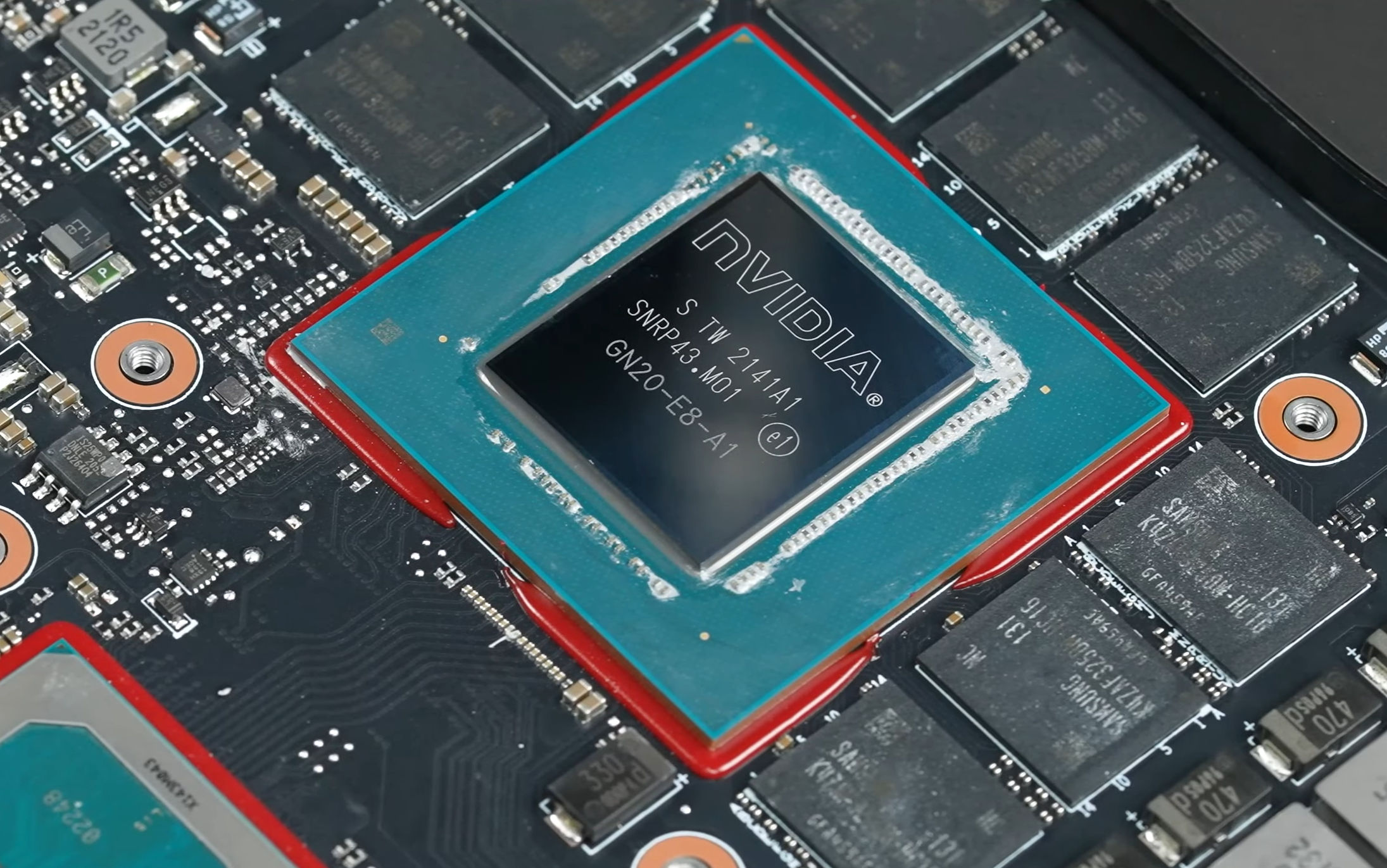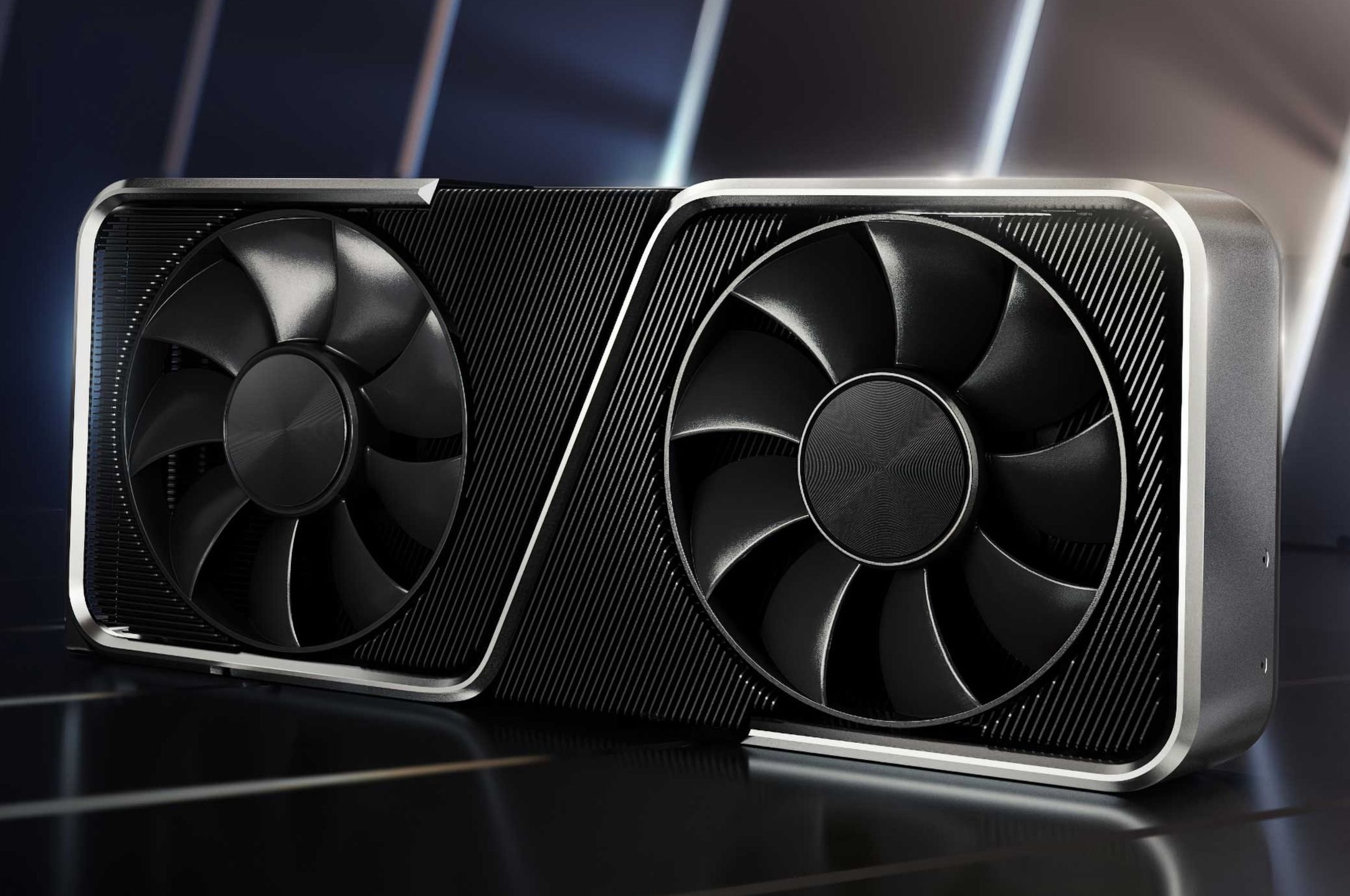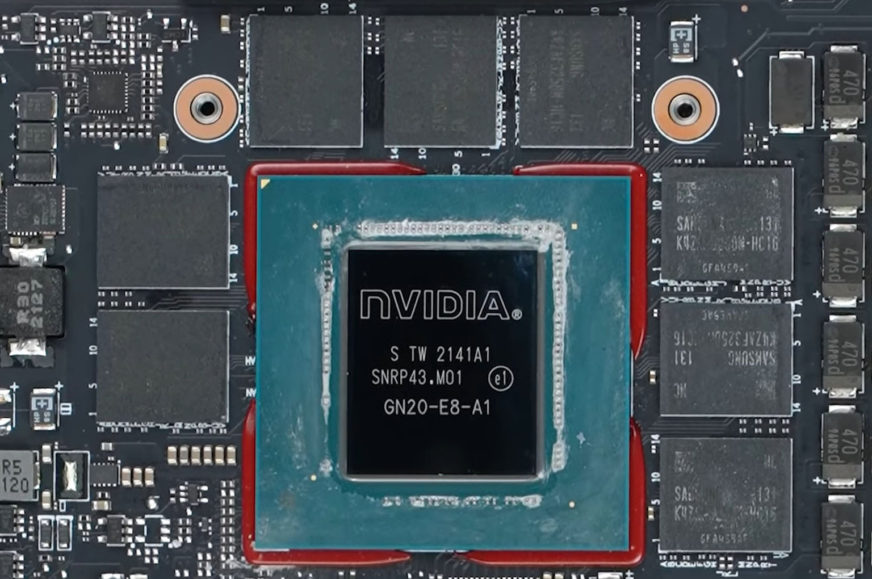New GPUs with size between GA104 and GA102. Desktop only gets leftovers for now, though
Nvidia’s Ampere graphics were initially based on the GA102 (RTX 3090, 3080) and GA104 (RTX 3070, 3060 Ti) chips, with the smaller GA106 and GA107 coming later. Interestingly, there was aslo talk of GA103 chip from the very star that didn’t show up. A year after Ampere’s release, it came to life in the form of mobile GeForce RTX 3080 Ti. Now we’ve got its first photo, as well as news that it’s making its way to desktop cards…
Physical design and specifications of GA103
One of the upcoming laptops with mobile GeForce RTX 3080 Ti has provided the internet with photos of the GA103 chip, courtesy of Chinese youtuber Geekerwan. The silicon shown, larger than the GA104 but in a package smaller than the GA102’s, is prominently labelled GN20-E8-A1. That’s a separate naming scheme that Nvidia uses for mobile versions of the GPU, but it should be the same chip that would be named GA103 on a desktop card.
The photos thus conclusively confirm the existence of this GPU, which was ironically listed among other Ampere chips back in May 2019, when the list and specs of the 8nm generation GPUs were published by the extraordinarily knowledgeable leaker Kopite7kimi more than a year before the launch. According to Geekerwan, the chip has a surface area of around 496 mm2, making it roughly 26% larger than the GA104 (392 mm2). The GA102 is in turn also about 25% larger than the GA103, at 628 mm2.

The GeForce RTX 3080 Ti for laptops will feature 7424 shaders (58 blocks of SM/RT cores) and a 256-bit memory bus – the laptop PCB photo also clearly shows the eight chips that the 256-bit width corresponds to. However, this is not the “full fat” of the GA103 chip. According to unofficial information from Kopite7kimi, among others, the chip is actually supposed to have 7680 shaders (60 SM/RT cores), of which the RTX 3080 Ti has two SM/256 shaders disabled to allow for defective die harvesting. This way, it is possible to capitalize on chips even with some defect present by turning off the affected unit.
But this is not the only deactivation done. Somewhat less common sight is that Nvidia doesn’t even use the full width of the memory controller. The GA103 is said to actually have a memory bus width of 320 bits, so it also supports 10GB/20GB memory and accordingly higher bandwidth. However, this is not used in the mobile RTX 3080 Ti, it is just a kind of headroom for possible further application of the chips. Nvidia could possibly capitalize on this capability in the desktop version if it ever comes out. It’s possible that 320-bit memory would require a different BGA package than the one in the photo, though. In fact, previous leaks have talked about there being a 320bit version of the GA103 and a separate 256bit version called “GA103S” (so that’s probably what’s on the photo).
Desktop version? Only an RTX 3060 Ti variant for now
We mentioned that Nvidia could release some card with this GPU – onethat could have 8-10GB of memory (or alternatively 16-20GB) and the number of compute units could be somewhere between the desktop GeForce RTX 3070 Ti and RTX 3080. It’s true though that the naming scheme leaves almost no room between them, unless Nvidia resorts to something like a RTX 3080 LE or RTX 3075 Ti name. Or unless they use the confusing practice of recycling an existing name, such as RTX 3070 Ti, but stamping it on a card that has a different number of hardware units or other specs, which is something Nvidia has been fond of lately.
The bad news is that such a high performance desktop card with GA103 is not confirmed at this point. But we do have information that the GA103 chip will make its way into a cheaper graphics card, that doesn’t actually need the potential of the GA103. Instead, these cards will probably use defective chips that would otherwise be unusable.

Specifically, Nvidia is preparing a new version of GeForce RTX 3060 Ti based on the GA103 chip. Or perhaps more likely a GA103S version (but the designation is said to be GA103-200). This card normally contains cut-down smaller GA104 chips which have only 4864 (38 SM) of their 6144 shaders (48 SM) enabled. But Nvidia seems to be preparing a second card that will use GA103 chips instead, cut-down from 7680 to probably also 4864 shaders to keep the specs unchanged. In theory the card could use more units at a lower frequency, but according to Kopite7kimi, the card’s specs are said to be the same as the GA104 version which would rule that option out. So the 8GB memory capacity and 256-bit bus will probably remain unchanged as well.
The existence of this alternative RTX 3060 Ti model was first revealed by PCI IDs found in Nvidia’s drivers (Studio driver version 511). Then, a mention also appeared in the AIDA64 utility, which has the addition of support for “NVIDIA GeForce RTX 3060 Ti (GA103)” listed in the release notes for the 6.60.5918 beta version. It is possible that the authors have the information under an NDA or from other internal sources. Then this entry would confirm that the rumors about GA103 usage in RTX 3060 Ti cards are true.

If you were to buy such a GeForce RTX 3060 Ti version, there shouldn’t be any performance implications for you. Actually, it will be interesting to compare the cards and check if there isn’t some surprise change in behaviour, but it is unlikely, the performance will probably be equivalent. The power draw of the larger chip could be a bit different (a bit worse) in theory, and the overclocking characteristics could also change. On the other hand, with the same power draw, the GA103 version might be easier to cool due to larger contact area. However, there’s probably not going to be any outrage where it would be advisable to avoid or alternatively prefer these cards.
The most important element here is mainly that the use of defective chips will allow Nvidia to produce more cards, so the GeForce RTX 3060 Ti could become a little more available and a little less overpriced in stores thanks to this…
Sources: VideoCardz (1, 2), Tom’s Hardware, Geekerwan, AIDA64, Kopite7kimi
English translation and edit by Jozef Dudáš, original text by Jan Olšan, editor for Cnews.cz
⠀








